
|
Great outburst occured on Oct. 24, 2007, and it bacame a naked eye comet of 2 mag. It kept so bright as 5.5 mag still on Apr. 30 (Carlos Labordena), but it was extremely faint and difficult to see. The size was so large, the diameter was larger than 60 arcmin. It will become observable in good condition in autumn again. The extremely faint large diffuse object may be detected with a best sky condition, around 5-6 mag with a diameter of 1 or 2 degrees. Now the nuclear brightness is 18.5 mag (Oct. 2, Francois Kugel). The coma and tail around the nucleus looks bright, and the total magnitude of the central part may be around 15 mag. Maybe visible visually with a large telescope.
Date(TT) R.A. (2000) Decl. Delta r Elong. m1 Best Time(A, h)
Oct. 4 8 57.73 26 49.6 4.221 3.856 62 6.1 4:06 (231, 6)
Oct. 11 9 3.22 26 28.7 4.149 3.882 67 6.0 3:55 (229, 8)
|
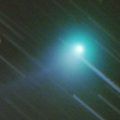
|
It reached to 6.3 mag in September in the southern sky (Sept. 4, Marco Goiato). Now it is still bright as 7.3 mag (Oct. 2, Marco Goiato). It became observable in the evening low sky also in the Northern Hemisphere. It keeps locating in the evening low sky until the end of 2008 when it fades out down to 10 mag. Then it turns to appear in the morning sky, and it keeps observable in the northern sky after that while fading gradually. In the Southern Hemisphere, it is only observable until late October.
Date(TT) R.A. (2000) Decl. Delta r Elong. m1 Best Time(A, h)
Oct. 4 15 30.54 -22 57.0 1.517 1.076 45 6.7 19:31 ( 80, 26)
Oct. 11 15 54.12 -18 5.1 1.597 1.091 42 6.9 19:38 ( 83, 21)
|
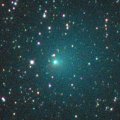
|
Now it is 8.5 mag (Sept. 24, Juan Jose Gonzalez). Now it is brightest, expanding the large coma. It keeps bright as 9 ma until late October. In the Northern Hemisphere, it keeps observable until it fades out. Although it locates extremely low now, it will be getting higher slowly after this.
Date(TT) R.A. (2000) Decl. Delta r Elong. m1 Best Time(A, h)
Oct. 4 22 15.21 -39 12.5 0.646 1.470 125 8.5 21:22 ( 0, 86)
Oct. 11 22 31.81 -38 39.0 0.712 1.502 121 8.7 21:11 ( 0, 86)
|
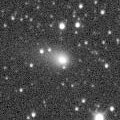
|
Now it is 9.4 mag (Oct. 2, Marco Goiato), brighter than this ephemeris. It is expected to reach to 6 mag in 2009 February. Getting lower in the evening sky. It will be unobservable temporarily in November, but it will appear in the morning sky again at 9 mag in late December.
Date(TT) R.A. (2000) Decl. Delta r Elong. m1 Best Time(A, h)
Oct. 4 16 31.20 -20 37.3 2.228 1.903 58 10.5 19:31 ( 89, 37)
Oct. 11 16 25.79 -20 28.8 2.302 1.829 50 10.3 19:38 ( 84, 29)
|
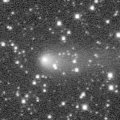
|
Now it is bright as 11.3 mag (Oct. 4, Seiichi Yoshida). It keeps observable in good conditioni as bright as 11 mag from autumn to winter. It keeps observable, visible visually, brighter than 14 mag for a long time until 2009 May.
Date(TT) R.A. (2000) Decl. Delta r Elong. m1 Best Time(A, h)
Oct. 4 6 1.40 58 39.1 2.078 2.440 98 11.2 4:06 (188, -5)
Oct. 11 6 14.51 59 18.9 2.027 2.447 102 11.1 3:55 (188, -5)
|
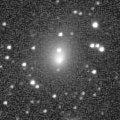
|
Brightening very rapidly, faster than expected. It is already so bright as 10.8 mag (Oct. 4, Seiichi Yoshida). Strongly condensed and easy to see. It is expected to reach to 10 mag in 2009 summer. Because it moves in the northern sky, it keeps observable until it becomes brightest in the Northern Hemisphere.
Date(TT) R.A. (2000) Decl. Delta r Elong. m1 Best Time(A, h)
Oct. 4 1 18.07 76 33.4 3.659 4.075 107 11.5 0:30 (180,-22)
Oct. 11 0 29.63 76 2.0 3.570 4.034 110 11.4 23:04 (180,-21)
|

|
It is expected to reach up to 7 mag in winter, and will be observable in good condition. However, this comet has not been observed since 1986. It is predicted to be brightening up to around 11-12 mag, bright enough to be recovered. However, it was not detected, fainter than 20 mag on Sept. 26 (Gustavo Muler). It seems much fainter than expected. The condition of this apparition is good. It keeps observable for a long time until 2009 early summer both in the Northern Hemisphere and Southern Hemisphere. Maybe it can brighten very rapidly near by the perihelion.
Date(TT) R.A. (2000) Decl. Delta r Elong. m1 Best Time(A, h)
Oct. 4 19 39.77 -22 42.1 0.960 1.522 101 12.2 19:31 (139, 74)
Oct. 11 19 47.17 -21 51.3 0.960 1.465 96 11.5 19:38 (125, 69)
|
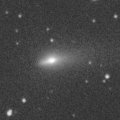
|
Now it is 10.8 mag (Sept. 29, Juan Jose Gonzalez). Brighter than originally expected. It keeps observable and fading in the morning sky after this. In the Southern Hemisphere, it keeps extremely low, or under the horizon, so it will not be observable.
Date(TT) R.A. (2000) Decl. Delta r Elong. m1 Best Time(A, h)
Oct. 4 10 15.90 27 58.6 2.088 1.594 47 11.5 4:06 (241, -8)
Oct. 11 10 36.97 27 43.3 2.086 1.635 50 11.7 3:55 (242, -8)
|
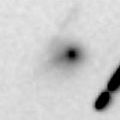
|
An outburst occured in late May and it brightened up to 14.6 mag (May 23, Gustavo Muler), but it faded down to the original brightness in late May. Then it had been reported so faint as 17 mag by CCD observations. However, it suddenly became so bright and visible visually after late August. Now it is so bright as 11.0 mag visually (Sept. 24, Juan Jose Gonzalez). Much brighter than originally predicted, by 3 mag. However, the nuclear magnitude by CCD is so faint as 16.6 mag (Sept. 9, Yasukazu Ikari). It locates extremely low in the Northern Hemisphere.
Date(TT) R.A. (2000) Decl. Delta r Elong. m1 Best Time(A, h)
Oct. 4 15 40.38 -19 16.0 1.719 1.256 46 11.6 19:31 ( 84, 27)
Oct. 11 16 5.71 -22 17.3 1.739 1.265 45 11.8 19:38 ( 80, 26)
|
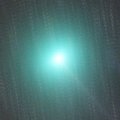
|
It became so bright as 4.7 mag, and so large as 20 arcmin in June (June 12, Marco Goiato). Now it is fading. But it is still visible visually at 12.4 mag (Oct. 4, Seiichi Yoshida). It keeps observable in good condition for a long time after this. Although it is extremely diffuse now, it will be visible visually for some more time in the excellent sky condition.
Date(TT) R.A. (2000) Decl. Delta r Elong. m1 Best Time(A, h)
Oct. 4 1 3.55 21 46.0 0.925 1.900 161 11.7 0:13 (180, 33)
Oct. 11 0 52.80 20 43.8 1.009 1.992 165 12.1 23:30 (180, 34)
|
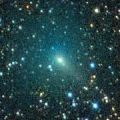
|
Diffuse comet, but it brightened up to 9.8 mag on July 7 (Juan Jose Gonzalez). Now it is fading, but still bright as 12.1 mag (Oct. 4, Seiichi Yoshida). In the Northern Hemisphere, it keeps observable until 2009 spring when the comet becomes faint. It will move near by the Northern Pole from summer to autumn, and will be observable all night. It will be visible visually for some more time. In the Southern Hemisphere, it will never be observable again.
Date(TT) R.A. (2000) Decl. Delta r Elong. m1 Best Time(A, h)
Oct. 4 12 51.99 84 53.0 1.774 2.025 89 12.0 19:31 (174,-37)
Oct. 11 12 55.48 85 37.9 1.770 2.072 92 12.3 3:55 (185,-37)
|
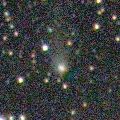
|
Now it is bright as 11.5 mag (Aug. 4, Marco Goiato). It keeps bright at 12 mag for a long time from 2008 spring to 2009 spring. However, it is not observable in the Northern Hemisphere. It will appear in the northern sky again in 2009 autumn, but it will be fainter than 15 mag and will keep locating very low after that. In the Southern Hemisphere, it keeps observable for a long time until it fades out, although it becomes low in autumn.
Date(TT) R.A. (2000) Decl. Delta r Elong. m1 Best Time(A, h)
Oct. 4 15 25.77 -44 57.3 3.145 2.687 54 12.3 19:31 ( 55, 34)
Oct. 11 15 30.65 -46 22.7 3.204 2.675 50 12.3 19:38 ( 52, 30)
|
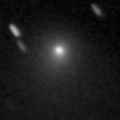
|
It reached to 10.9 mag in May (May 11, Marco Goiato). Now it is fading slowly. It has faded down to 12.0 mag on July 21 (Alexandre Amorim). Now it is not observable. In the Northern Hemisphere, it will appear in the morning sky again at 13 mag at the end of 2008, then it keeps bright and observable for a while.
Date(TT) R.A. (2000) Decl. Delta r Elong. m1 Best Time(A, h)
Oct. 4 13 31.12 -1 43.8 3.888 2.922 12 12.4 19:31 ( 81,-10)
Oct. 11 13 42.17 -1 32.0 3.922 2.946 10 12.5 19:38 ( 77,-15)
|
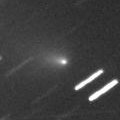
|
It had been lost for 112 years sincd 1896, but re-discovered by Koichi Itagaki and Hiroshi Kaneda on Sept. 10. It should be bright temporarily in outburst now. However, it still keeps bright as 12.6 mag (Oct. 4, Seiichi Yoshida). It keeps locating high in the evening sky for a while after this, but it can fade out rapidly.
Date(TT) R.A. (2000) Decl. Delta r Elong. m1 Best Time(A, h)
Oct. 4 21 18.83 -9 33.4 0.716 1.547 127 13.5 20:26 (180, 65)
Oct. 11 21 33.38 -11 12.5 0.764 1.560 124 13.7 20:13 (180, 66)
|

|
An large outburst occured on Sept. 21, and it became so bright as 11.3 mag (Juan Antonio Henriquez Santana). It is still bright as 10.4 mag (Oct. 4, Seiichi Yoshida). Now the diameter is 2-3 arcmin, looks very large and diffuse.
Date(TT) R.A. (2000) Decl. Delta r Elong. m1 Best Time(A, h)
Oct. 4 8 10.63 23 31.9 6.312 6.067 71 13.9 4:06 (225, 16)
Oct. 11 8 13.63 23 22.2 6.206 6.069 77 13.8 3:55 (223, 18)
|

|
Now it is 15.1 mag (Aug. 1, John Drummond). It is extremely low in the Northern Hemisphere now, but observable in good condition in the Southern Hemisphere. It is expected to brighten up to 10 mag from late 2009 to early 2010. Because the comet moves in the southern sky for a long time, it keeps impossible or very hard to observe in the Northern Hemisphere until 2009 September. But after 2009 October, it is observable at 10 mag for a while in good condition. In the Southern Hemisphere, it keeps observable for a long time while brightening until 2009 June when it brightens to 11 mag. But it becomes unobservable around and after the brightest time.
Date(TT) R.A. (2000) Decl. Delta r Elong. m1 Best Time(A, h)
Oct. 4 6 15.06 -46 25.9 4.353 4.487 91 14.0 4:06 (314, 72)
Oct. 11 6 17.87 -47 32.3 4.267 4.430 92 13.9 3:55 (322, 73)
|
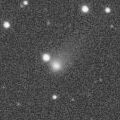
|
It brightened up to 12.7 mag in spring (Apr. 12, Marco Goiato). However, it has already faded down to 14.9 mag (July 22, Mitsunori Tsumura). It will never be observable again in the Northern Hemisphere. In the Southern Hemisphere, it will be unobservable in October, but it will appear again in the morning sky at 15 mag in winter.
Date(TT) R.A. (2000) Decl. Delta r Elong. m1 Best Time(A, h)
Oct. 4 14 11.63 -26 58.0 3.816 3.007 31 14.4 19:31 ( 66, 13)
Oct. 11 14 23.51 -28 21.6 3.862 3.018 28 14.4 19:38 ( 62, 9)
|

|
Now it is 12.6 mag (Sept. 6, Juan Jose Gonzalez), bright and visible visually. It will be getting lower in the evening sky after this, and will be too low to observe in October. But it will locate high again in winter, and will be visible visually at 14 mag.
Date(TT) R.A. (2000) Decl. Delta r Elong. m1 Best Time(A, h)
Oct. 4 14 55.42 18 44.4 6.631 5.906 40 14.7 19:31 (110, -5)
Oct. 11 14 56.94 18 32.0 6.684 5.922 37 14.7 19:38 (105,-11)
|

|
It was 15 mag on Jan. 14 (Michael Mattiazzo), brightening as expected. It should have reached up to 13.5 mag in summer in the southern sky. Now it is fading. In the Southern Hemisphere, it keeps observable for a long time after this. But in the Northern Hemisphere, it is not observable now. But it will appear in the morning sky at 15 mag in November, then it keeps observable while the comet will be fading slowly.
Date(TT) R.A. (2000) Decl. Delta r Elong. m1 Best Time(A, h)
Oct. 4 11 3.37 -30 13.3 3.581 2.815 34 14.8 4:06 (296, 16)
Oct. 11 11 13.56 -30 5.0 3.608 2.850 35 14.8 3:55 (295, 17)
|
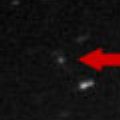
|
Now it is 15.6 mag (Sept. 18, Siding Spring Survey). It will reach up to 14.5 mag in autumn. However, then it locates low in the evening sky, and it will be unobservable soon in December.
Date(TT) R.A. (2000) Decl. Delta r Elong. m1 Best Time(A, h)
Oct. 4 16 45.81 -12 41.8 2.367 2.077 61 15.0 19:31 (100, 36)
Oct. 11 16 59.33 -13 27.7 2.394 2.042 57 14.9 19:38 ( 96, 32)
|
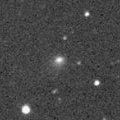
|
Now it is 15.3 mag (Sept. 7, Ken-ichi Kadota). It will be observable at 15 mag in good condition in next autumn. It is also observed visually at 14.3 mag (Sept. 28, Alan Hale).
Date(TT) R.A. (2000) Decl. Delta r Elong. m1 Best Time(A, h)
Oct. 4 2 49.47 23 42.6 2.517 3.374 143 15.1 1:59 (180, 31)
Oct. 11 2 29.91 23 17.8 2.459 3.385 154 15.0 1:12 (180, 32)
|
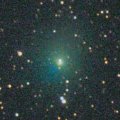
|
It reached up to 9.5 mag on Mar. 29 (Maik Meyer). Now it is fading slowly. It faded down to 10.7 mag on May 11 (Marco Goiato), and it was a diffuse object with a weak condensation. In the Northern Hemisphere, it will never be observable again. In the Southern Hemisphere, it keeps observable until it fades out. No observations have been reported recently, and the current brightness is uncertain.
Date(TT) R.A. (2000) Decl. Delta r Elong. m1 Best Time(A, h)
Oct. 4 12 11.72 -54 31.9 3.206 2.683 50 15.1 4:06 (324, 19)
Oct. 11 12 31.72 -56 25.6 3.295 2.759 49 15.3 3:55 (326, 19)
|
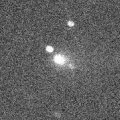
|
Brightening more rapidly than expected, and coming closer to the earth. It passes near by earth in October. Now it is visible visually at 14.5 mag (Sept. 28, Bob King). However, it will fade out rapidly in November, and will be fainter than 18 mag in late December.
Date(TT) R.A. (2000) Decl. Delta r Elong. m1 Best Time(A, h)
Oct. 4 2 30.32 8 29.1 0.426 1.392 152 15.3 1:39 (180, 47)
Oct. 11 2 36.94 9 30.0 0.409 1.385 157 15.1 1:18 (180, 46)
|
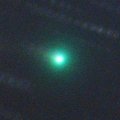
|
It brightened up to 9.2 mag on July 15 (Juan Jose Gonzalez). It was bright as 10.9 mag still on Aug. 9 (Juan Jose Gonzalez). However, it is fading rapidly after mid August. It is already invisible visually, fainter than 13.1 mag (Sept. 9, Seiichi Yoshida). It has already faded down to 14.9 mag on Sept. 9 by CCD (Ken-ichi Kadota). However, the location will be better after this. It keeps observable by CCD until it fades out in winter.
Date(TT) R.A. (2000) Decl. Delta r Elong. m1 Best Time(A, h)
Oct. 4 8 37.34 24 54.5 1.844 1.700 65 15.2 4:06 (229, 11)
Oct. 11 8 48.77 24 32.6 1.837 1.768 70 15.7 3:55 (228, 12)
|
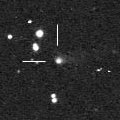
|
Now it is 14.7 mag (Oct. 1, Juan Jose Gonzalez), already visible visually. It will be brightening gradually after this, and reach to 12-13 mag in 2009 winter and spring. In the Northern Hemisphere, it keeps observable for a long time until 2009 May.
Date(TT) R.A. (2000) Decl. Delta r Elong. m1 Best Time(A, h)
Oct. 4 20 42.82 -28 25.8 1.448 2.070 114 15.5 19:49 (180, 83)
Oct. 11 20 43.68 -27 50.7 1.474 2.016 107 15.4 19:38 (154, 82)
|
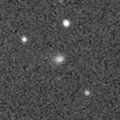
|
It had been so faint as 18 mag until July. However, an outburst occured on Aug. 3 and brightened up to 14.5 mag (Gustavo Muler). But it is already fading. It has already faded down to 15.4 mag (Sept. 13, Gustavo Muler). It will be too low to observe in October.
Date(TT) R.A. (2000) Decl. Delta r Elong. m1 Best Time(A, h)
Oct. 4 15 31.21 -8 35.2 3.884 3.220 42 15.4 19:31 ( 92, 19)
Oct. 11 15 40.09 -9 44.0 3.925 3.200 38 15.6 19:38 ( 88, 14)
|
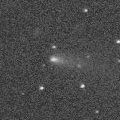
|
Now it is 15.4 mag (Sept. 5, S. Sanchez et al.). It will be observable at 16 mag in good condition in autumn.
Date(TT) R.A. (2000) Decl. Delta r Elong. m1 Best Time(A, h)
Oct. 4 3 35.13 11 10.2 1.280 2.119 136 15.7 2:44 (180, 44)
Oct. 11 3 35.31 10 36.3 1.241 2.125 143 15.7 2:17 (180, 44)
|
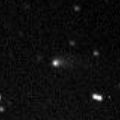
|
Now it is 15.6 mag (Aug. 7, Ken-ichi Kadota). It locates somewhat low in the Northern Hemisphere, but it keeps observable around 16 mag until winter. It is also observed visually at 14.6 mag (Aug. 6, Juan Jose Gonzalez).
Date(TT) R.A. (2000) Decl. Delta r Elong. m1 Best Time(A, h)
Oct. 4 20 55.18 -26 6.8 2.281 2.883 117 15.7 20:01 (180, 81)
Oct. 11 20 56.85 -25 17.7 2.356 2.874 111 15.8 19:38 (177, 80)
|

|
Now it is 17.2 mag (Sept. 10, Ken-ichi Kadota). It will brighten rapidly after this. It will be observable at 12-13 mag for a long time from January to July in 2009.
Date(TT) R.A. (2000) Decl. Delta r Elong. m1 Best Time(A, h)
Oct. 4 8 46.38 21 20.4 3.200 2.884 62 16.1 4:06 (233, 12)
Oct. 11 8 55.95 20 48.2 3.089 2.858 67 15.9 3:55 (232, 13)
|
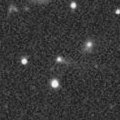
|
Now it is 16.4 mag (Aug. 31, J. A. Henriquez). Brightened rapidly, and it still keeps brightening even after passing the perihelion. It will be observable at 16 mag in good condition until November. It is also observed visually at 14.8 mag (Sept. 29, Juan Jose Gonzalez).
Date(TT) R.A. (2000) Decl. Delta r Elong. m1 Best Time(A, h)
Oct. 4 0 57.38 23 54.0 1.388 2.353 160 16.0 0:07 (180, 31)
Oct. 11 0 55.14 21 54.0 1.387 2.365 164 16.0 23:33 (180, 33)
|

|
Not recovered yet. It is predicted to be already brightening up to 16 mag. It will reach up to 16 mag until November, and will be observable in good condition. But actually, it may be much fainter than expected. It keeps observable in the morning sky until January when it will be fainter than 18 mag.
Date(TT) R.A. (2000) Decl. Delta r Elong. m1 Best Time(A, h)
Oct. 4 8 24.45 10 58.8 0.986 1.075 65 16.3 4:06 (236, 23)
Oct. 11 9 1.85 7 48.4 0.980 1.029 62 16.1 3:55 (243, 22)
|
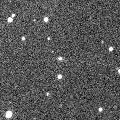
|
Getting higher gradually in the morning sky. It will be observable at 15 mag in good condition in winter.
Date(TT) R.A. (2000) Decl. Delta r Elong. m1 Best Time(A, h)
Oct. 4 9 1.66 21 3.0 4.111 3.702 59 16.4 4:06 (236, 10)
Oct. 11 9 8.82 20 43.4 4.014 3.696 64 16.4 3:55 (234, 11)
|
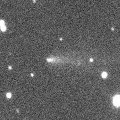
|
Now it is 15.2 mag (Aug. 2, Ken-ichi Kadota). Now it is brightest, and it will be fading after this. It keeps observable in good condition until it fades out in winter. The position is very different from the original prediction. It is also observed visually at 14.0 mag (Sept. 7, Juan Jose Gonzalez).
Date(TT) R.A. (2000) Decl. Delta r Elong. m1 Best Time(A, h)
Oct. 4 4 52.31 17 34.1 1.306 1.973 117 16.4 4:01 (180, 37)
Oct. 11 4 54.18 17 45.6 1.275 2.007 123 16.6 3:35 (180, 37)
|
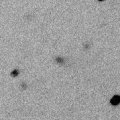
|
Now it is 17.5 mag (Sept. 13, A. Sanchez). It will be observable at 16 mag in good condition from autumn to winter.
Date(TT) R.A. (2000) Decl. Delta r Elong. m1 Best Time(A, h)
Oct. 4 2 34.19 29 40.4 1.761 2.630 143 16.6 1:43 (180, 25)
Oct. 11 2 31.17 29 57.2 1.697 2.608 149 16.5 1:13 (180, 25)
|
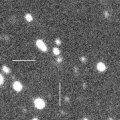
|
It will be observable at 16.5-17 mag in good condition in autumn. It will be fainter than 18 mag in February.
Date(TT) R.A. (2000) Decl. Delta r Elong. m1 Best Time(A, h)
Oct. 4 18 40.56 20 51.2 1.699 1.995 91 16.9 19:31 (152, 29)
Oct. 11 18 48.27 21 13.4 1.730 1.973 88 16.8 19:38 (146, 26)
|

|
Now it is 17.8 mag (Aug. 3, Ken-ichi Kadota). It will brighten up to 12 mag in 2012. It is faint still in 2008, but observable at 17 mag in good condition.
Date(TT) R.A. (2000) Decl. Delta r Elong. m1 Best Time(A, h)
Oct. 4 22 55.14 5 41.6 9.442 10.348 153 17.0 22:00 (180, 49)
Oct. 11 22 51.95 5 19.4 9.463 10.311 146 17.0 21:30 (180, 50)
|
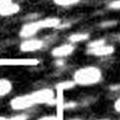
|
It was observed at 16.5-17 mag in 2007 autumn. Now it is 17.3 mag (July 2, J. F. Hernandez). It will be observable at 17 mag for a long time from summer to autumn.
Date(TT) R.A. (2000) Decl. Delta r Elong. m1 Best Time(A, h)
Oct. 4 5 10.00 28 26.9 2.151 2.690 111 17.1 4:06 (183, 26)
Oct. 11 5 11.14 28 31.5 2.096 2.718 118 17.1 3:52 (180, 26)
|
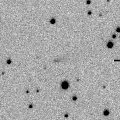
|
Now it is 17.5 mag (Aug. 31, Michael Jager). Recovered as bright as expected. It will getting higher, but will be fading gradually after this. It will be fainter than 18 mag in December.
Date(TT) R.A. (2000) Decl. Delta r Elong. m1 Best Time(A, h)
Oct. 4 9 25.79 20 44.0 1.864 1.510 53 17.1 4:06 (240, 6)
Oct. 11 9 44.31 19 33.4 1.858 1.547 56 17.2 3:55 (241, 6)
|
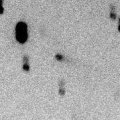
|
It is observable at 17.5 mag in good condition in autumn. It will be fainter than 18 mag in December.
Date(TT) R.A. (2000) Decl. Delta r Elong. m1 Best Time(A, h)
Oct. 4 1 47.54 26 22.2 0.795 1.745 152 17.4 0:57 (180, 29)
Oct. 11 1 45.01 27 12.7 0.770 1.736 157 17.3 0:27 (180, 28)
|
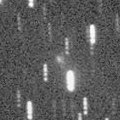
|
It was bright as 16.0 mag on June 30 (Michael Jager). Now it is 17.1 mag (Aug. 15, Ken-ichi Kadota). It keeps observable in good condition after this in the Northern Hemisphere. It will be fading gradually, and will be fainter than 18 mag in November.
Date(TT) R.A. (2000) Decl. Delta r Elong. m1 Best Time(A, h)
Oct. 4 22 1.00 57 13.2 2.261 2.877 118 17.4 21:06 (180, -2)
Oct. 11 21 57.41 56 23.7 2.323 2.932 118 17.5 20:35 (180, -1)
|

|
It reached up to 16 mag last winter. Now it is fading, but it will be observable at 17.5 mag in good condition from autumn to winter.
Date(TT) R.A. (2000) Decl. Delta r Elong. m1 Best Time(A, h)
Oct. 4 5 5.36 15 50.5 5.178 5.660 114 17.6 4:06 (182, 39)
Oct. 11 5 3.93 16 15.0 5.112 5.694 121 17.6 3:45 (180, 39)
|
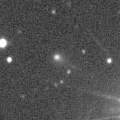
|
It was observed as bright as 14-15 mag in 2007 autumn. It will be observable at 17.5 mag in good condition from autumn to winter in 2008.
Date(TT) R.A. (2000) Decl. Delta r Elong. m1 Best Time(A, h)
Oct. 4 7 58.03 31 0.8 3.290 3.196 75 17.8 4:06 (218, 12)
Oct. 11 8 4.91 30 59.0 3.219 3.222 81 17.7 3:55 (217, 13)
|
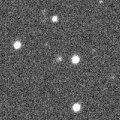
|
It will brighten up to 15 mag in 2009 and 2010. In this autumn, it is observable at 17.5 mag in good condition.
Date(TT) R.A. (2000) Decl. Delta r Elong. m1 Best Time(A, h)
Oct. 4 21 58.89 17 22.3 3.667 4.464 138 17.8 21:04 (180, 38)
Oct. 11 21 50.21 16 54.3 3.693 4.415 131 17.8 20:28 (180, 38)
|
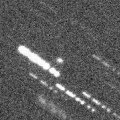
|
It keeps 17.5-18 mag for a long time until early summer in 2009. It becomes low in December, but it is observable in good condition except for that time.
Date(TT) R.A. (2000) Decl. Delta r Elong. m1 Best Time(A, h)
Oct. 4 17 33.89 36 11.2 3.108 3.083 79 17.9 19:31 (146, 9)
Oct. 11 17 29.51 34 3.5 3.177 3.065 74 17.9 19:38 (139, 5)
|
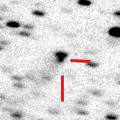
|
It was observed at 16.5-17 mag in 2006 and 2007. Because it is a very distant comet, it is observable at 17 mag still in 2008 in good condition.
Date(TT) R.A. (2000) Decl. Delta r Elong. m1 Best Time(A, h)
Oct. 4 17 28.87 39 23.9 6.743 6.627 79 17.9 19:31 (147, 5)
Oct. 11 17 28.81 38 51.7 6.820 6.650 76 17.9 19:38 (142, 2)
|
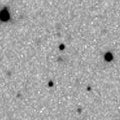
|
It is observable at 18 mag in good condition in autumn. It was predicted to be 16 mag based on the brightness at the discovery in 1997. But actually, it is fainter.
Date(TT) R.A. (2000) Decl. Delta r Elong. m1 Best Time(A, h)
Oct. 4 0 54.52 17 31.9 2.299 3.279 166 17.9 0:04 (180, 37)
Oct. 11 0 50.71 16 49.1 2.295 3.282 169 18.0 23:28 (180, 38)
|
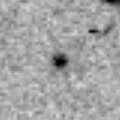
|
Now it is 18.1 mag (Sept. 29, S. Gajdos). It was origibally expected to reach up to 10 mag in winter based on the brightness at the discovery. However, it is actually much fainter than expected, and will be only 16 mag at best. It keeps observable in good condition for a long time until next spring.
Date(TT) R.A. (2000) Decl. Delta r Elong. m1 Best Time(A, h)
Oct. 4 3 23.77 22 44.0 1.050 1.904 136 18.4 2:32 (180, 32)
Oct. 11 3 27.28 22 50.1 0.964 1.859 142 18.1 2:08 (180, 32)
|
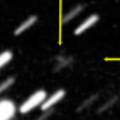
|
It was predicted to be so bright as 14 mag now. But actually, it is extremely faint as 19.5 mag (Aug. 4, Gustavo Muler). Although it locates in good condition, it will be hard to observe.
Date(TT) R.A. (2000) Decl. Delta r Elong. m1 Best Time(A, h)
Oct. 4 22 2.13 13 9.4 1.973 2.813 139 20.1 21:08 (180, 42)
Oct. 11 22 3.26 12 28.0 2.075 2.866 134 20.3 20:42 (180, 43)
|

|
It was observed at 16-17 mag at the discovery in 1999. However, it is much fainter than predicted in this apparition. Now it is 19.9 mag (Sept. 3, T. H. Bressi). It will be 18-19 mag at best.
Date(TT) R.A. (2000) Decl. Delta r Elong. m1 Best Time(A, h)
Oct. 4 23 52.72 3 17.7 3.038 4.022 168 20.2 22:58 (180, 52)
Oct. 11 23 48.90 2 52.0 3.050 4.004 160 20.2 22:27 (180, 52)
|
|
![]()
 19P/Borrelly
19P/Borrelly 7P/Pons-Winnecke
7P/Pons-Winnecke C/2007 W1 ( Boattini )
C/2007 W1 ( Boattini ) C/2008 J1 ( Boattini )
C/2008 J1 ( Boattini ) C/2007 G1 ( LINEAR )
C/2007 G1 ( LINEAR ) C/2006 Q1 ( McNaught )
C/2006 Q1 ( McNaught ) 205P/2008 R6 ( Giacobini )
205P/2008 R6 ( Giacobini ) 29P/Schwassmann-Wachmann 1
29P/Schwassmann-Wachmann 1 C/2007 Q3 ( Siding Spring )
C/2007 Q3 ( Siding Spring ) C/2007 B2 ( Skiff )
C/2007 B2 ( Skiff ) C/2005 L3 ( McNaught )
C/2005 L3 ( McNaught ) C/2006 U6 ( Spacewatch )
C/2006 U6 ( Spacewatch ) 68P/Klemola
68P/Klemola C/2007 U1 ( LINEAR )
C/2007 U1 ( LINEAR ) C/2008 C1 ( Chen-Gao )
C/2008 C1 ( Chen-Gao ) P/2008 Q2 ( Ory )
P/2008 Q2 ( Ory ) 15P/Finlay
15P/Finlay 67P/Churyumov-Gerasimenko
67P/Churyumov-Gerasimenko 199P/2008 G2 ( Shoemaker 4 )
199P/2008 G2 ( Shoemaker 4 ) 61P/Shajn-Schaldach
61P/Shajn-Schaldach 47P/Ashbrook-Jackson
47P/Ashbrook-Jackson 116P/Wild 4
116P/Wild 4 P/2008 L2 ( Hill )
P/2008 L2 ( Hill ) P/2001 J1 ( NEAT )
P/2001 J1 ( NEAT ) 74P/Smirnova-Chernykh
74P/Smirnova-Chernykh 51P/Harrington
51P/Harrington 59P/Kearns-Kwee
59P/Kearns-Kwee C/2008 R3 ( LINEAR )
C/2008 R3 ( LINEAR ) C/2006 S3 ( LONEOS )
C/2006 S3 ( LONEOS ) 44P/Reinmuth 2
44P/Reinmuth 2 201P/2008 Q4 ( LONEOS )
201P/2008 Q4 ( LONEOS ) P/2008 QP20 ( LINEAR-Hill )
P/2008 QP20 ( LINEAR-Hill ) C/2008 J6 ( Hill )
C/2008 J6 ( Hill ) C/2006 K1 ( McNaught )
C/2006 K1 ( McNaught ) 188P/2007 J7 ( LINEAR-Mueller )
188P/2007 J7 ( LINEAR-Mueller ) C/2008 N1 ( Holmes )
C/2008 N1 ( Holmes ) C/2008 Q1 ( Maticic )
C/2008 Q1 ( Maticic ) C/2005 S4 ( McNaught )
C/2005 S4 ( McNaught ) 200P/2008 L1 ( Larsen )
200P/2008 L1 ( Larsen ) 144P/Kushida
144P/Kushida C/2007 K3 ( Siding Spring )
C/2007 K3 ( Siding Spring ) 203P/2008 R4 ( Korlevic )
203P/2008 R4 ( Korlevic )![]()









































